| Home |
| Acknowledgments |
| Conventions |
| Glossary |
| Maps |
| References |
| Links |
| Articles |
| Thumbnails |
| Species
list |
| Family |
| Next
species |
Additional Photos

pale
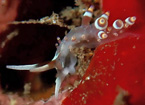
side
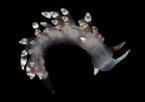
underside
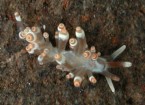
young, 4 mm

extended cerata
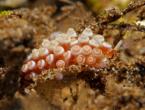
contracted cerata

contracted rhinophores
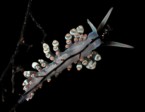
on hydroid
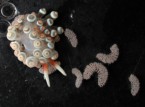
egg masses
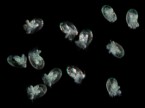
veligers

Tenellia sp. #25
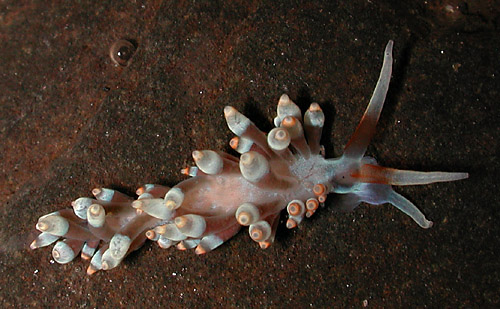
| Maximum size: 20 mm. Identification: This is a translucent-cream aeolid frosted with bluish white. The rhinophores are closely spaced with translucent-white tips and, sometimes, translucent-orange bases. The cerata have brown cores and bluish white tips with subapical orange rings. It differs from the similar appearing Anteaeolidiella cacaotica in lacking obvious cnidosacs in the tips of its cerata. Natural history: Tenellia sp. #25 is a moderately common aeolid. Most of the animals we've seen were found in association with the introduced hydroid Pennaria disticha in silty Halimeda kanaloana beds at depths of 8-12 m (26-39 ft). However, it has also be found in tide pools (by Heidi Miller as reported on The Odyssey of Dai Mar site) and in shallow, moderately exposed rocky habitats where it's host hydroid is common. In a dish, one animal showed a strong preference for resting on the hydroid and clung tenaciously to it. It was observed feeding on the stalks of the hydroid, though it ignored the polyps. Several pale pink, arc-shaped egg masses were attached to the base of the P. disticha colony when it was collected and the animal subsequently laid several comparable masses in a dish. The egg masses swelled during development and one hatched in about five days in the laboratory. (Note 1) Distribution: Big Island, Maui, Oahu and Kauai: also known from Guam, South Africa and French Polynesia. Taxonomic notes: It was first recorded in Hawaii from Maalaea Bay, Maui by CP on May 5, 2008 and was formerly placed in the genus Catriona. There's some chance that the young animal illustrated here is distinct. Photo: CP: 15 mm: Maalaea Bay, Maui; May 5, 2008. Observations and comments: Note 1: Jenna Szerlag reported seeing one contract its rhinophores, accordion-fashion, then relax them by about six minutes later. (see photos) Perhaps, it was responding to something in the water? |
| Thumbnails |
Species
list |
Family | Next species | Top |